In lung cancer, immunotherapy’s effectiveness as a first-line option has been quite dramatic, and ASCO18 revealed even more of its benefits in this cancer type, which claims more lives than any other in the United States.
Luis Paz-Ares, MD, PhD, of University Hospital October 12 in Madrid, Spain, began the day by highlighting the results of the Keynote-407 trial, in which patients with non-small cell lung cancer (NSCLC) that was both metastatic and of the squamous variety received combination chemotherapy with or without pembrolizumab, a PD-1 checkpoint immunotherapy.
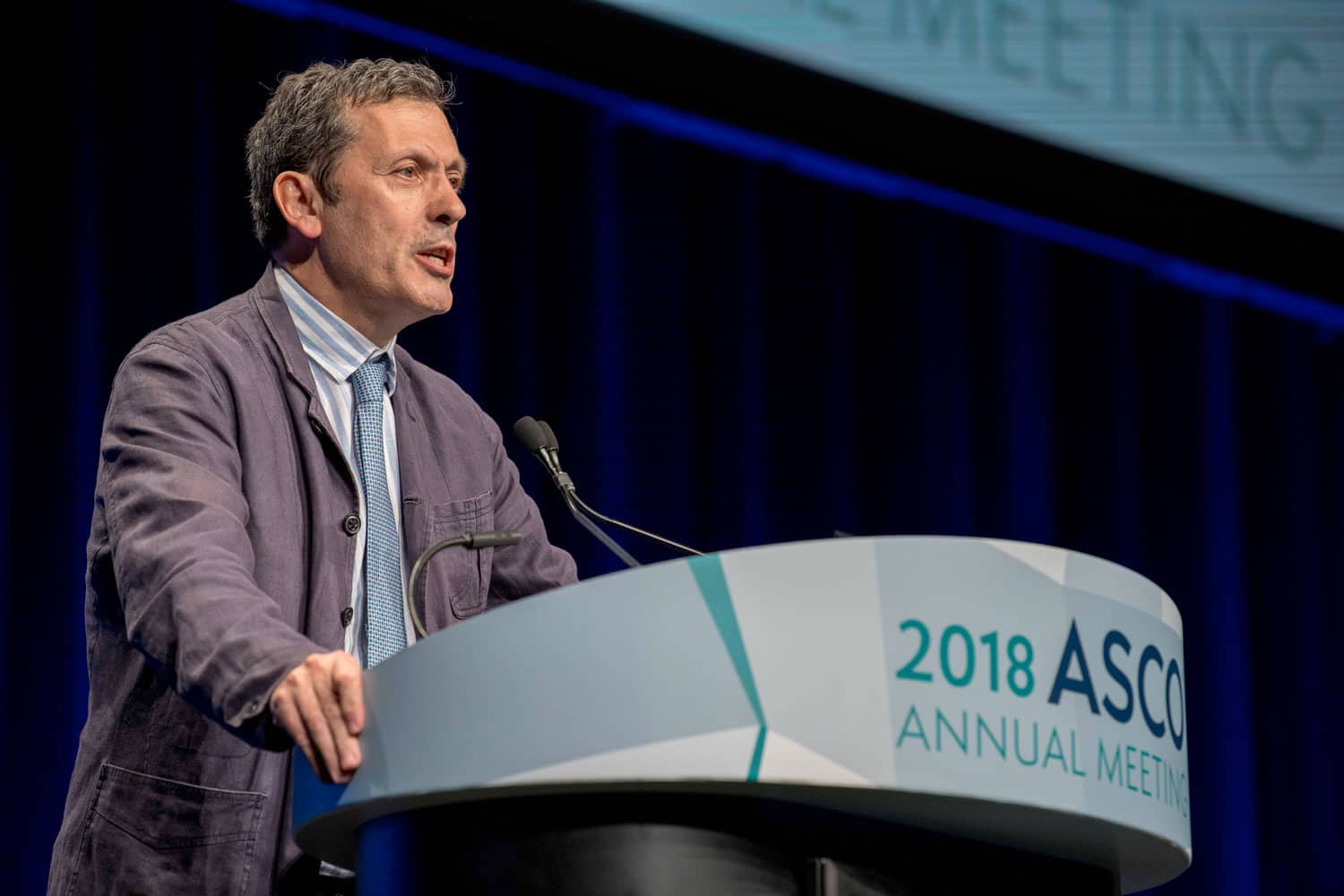
In the patients who also received immunotherapy, the median overall survival was 15.9 months, which was more than four months longer than that of the patients treated only with chemotherapy. Importantly, this benefit was seen in patients with high, low, and minimal/no PD-L1 expression, as evidenced by the corresponding reduction in risk of death by 36% (in high expression), 43% (low expression), and 39% (minimal expression), respectively. Expression of PD-L1, the companion molecule to the PD-1 receptor, has been associated with improved responses in some lung studies, though its true significance as a predictive biomarker remains murky.
There were also benefits associated with immunotherapy in terms of progression-free survival (hazard ratio = 0.56), response rate (58.4% compared to 35%), and disease control rate (84.1% compared to 68%). Responses also lasted longer in patients treated with the immunotherapy-containing regimen (median 7.7 months) compared to the chemotherapy-only cohort (median 4.8 months).
Later, during Sunday’s plenary session, Gilberto Lopes, MD, M.B.A., of the University of Miami’s Sylvester Comprehensive Cancer Center, revealed the superior benefits of pembrolizumab compared to chemotherapy as a first-line options for patients with advanced, PD-L1-expressing NSCLC that lacks EGFR mutations as well as ALK translocations.
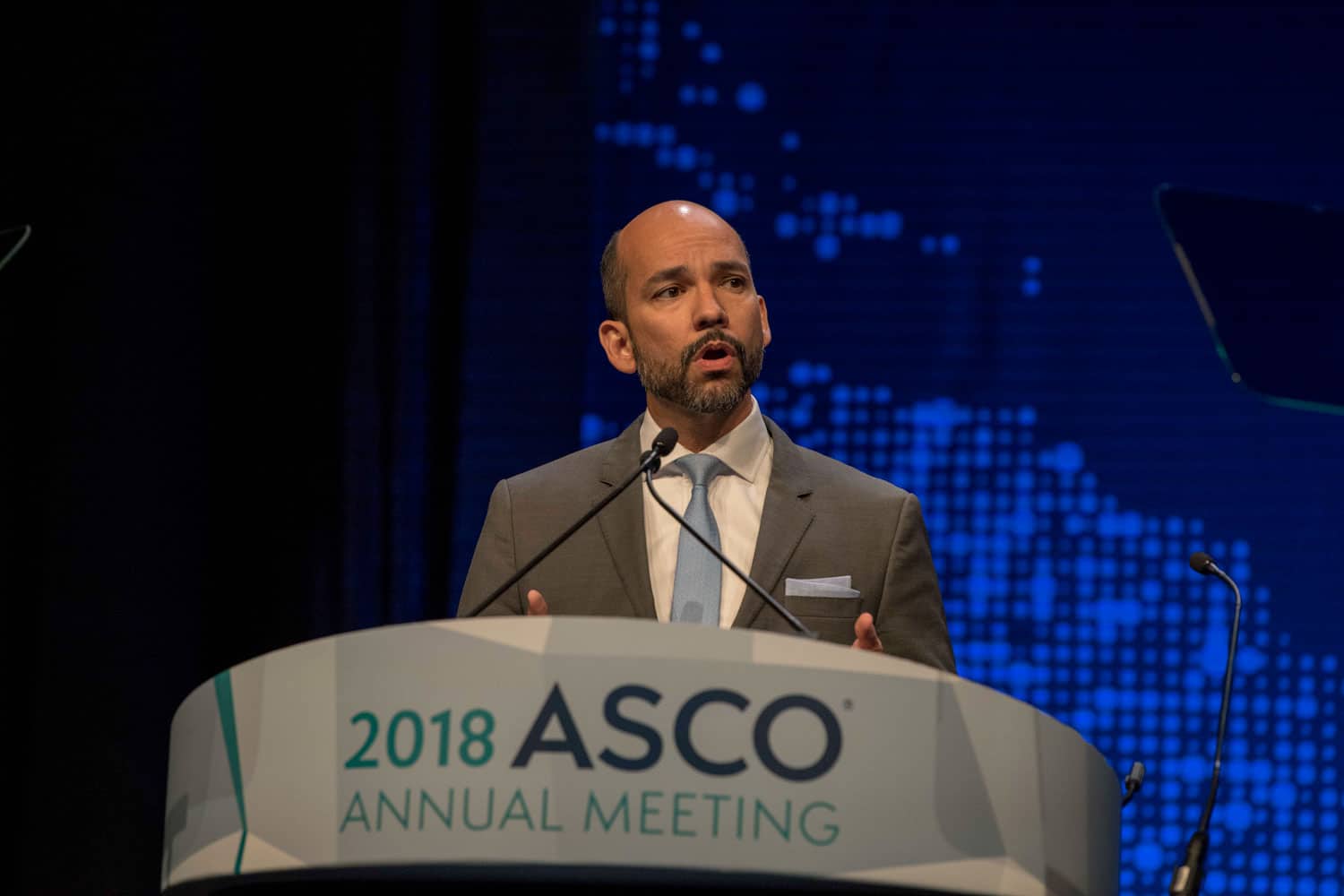
In the Keynote-042 trial, levels of PD-L1 expression greater than or equal to one percent, as measured by a PD-L1 tumor proportion score (TPS), were associated with an increased two-year overall survival rate (39.3% compared to 28%). While the response rate of the immunotherapy arm was only slightly higher (27.3% versus 26.5%), the immunotherapy-induced responses lasted much longer, with 53.4% of responses ongoing at a year and a half, compared to only 30.4% of the chemotherapy-induced responses.
Immunotherapy’s benefits were even more significant in patients whose tumors expressed higher levels of PD-L1. In patients with TPS ≥ 20%, the two-year overall survival rate was 40.5% versus 29.6%, and in those with TPS ≥ 50% it was 44.7% versus 30.1%. Impressively, pembrolizumab also led to fewer treatment-related adverse events, which affected 89.9% of the chemotherapy-treated patients but only 62.7% of the immunotherapy-treated patients. Serious (grade 3-5) treatment-related side effects were less frequent in the pembrolizumab-treated group (17.8% compared to 41%).
Following Dr. Lopes was Leena Gandhi, MD, PhD, of the Perlmutter Cancer Center at NYU Langone Health, who discussed Lopes’ findings from Keynote-042 as well as the general landscape of PD-1/PD-L1 immunotherapies in advanced lung cancer and how biomarkers can be used to guide treatment decisions.
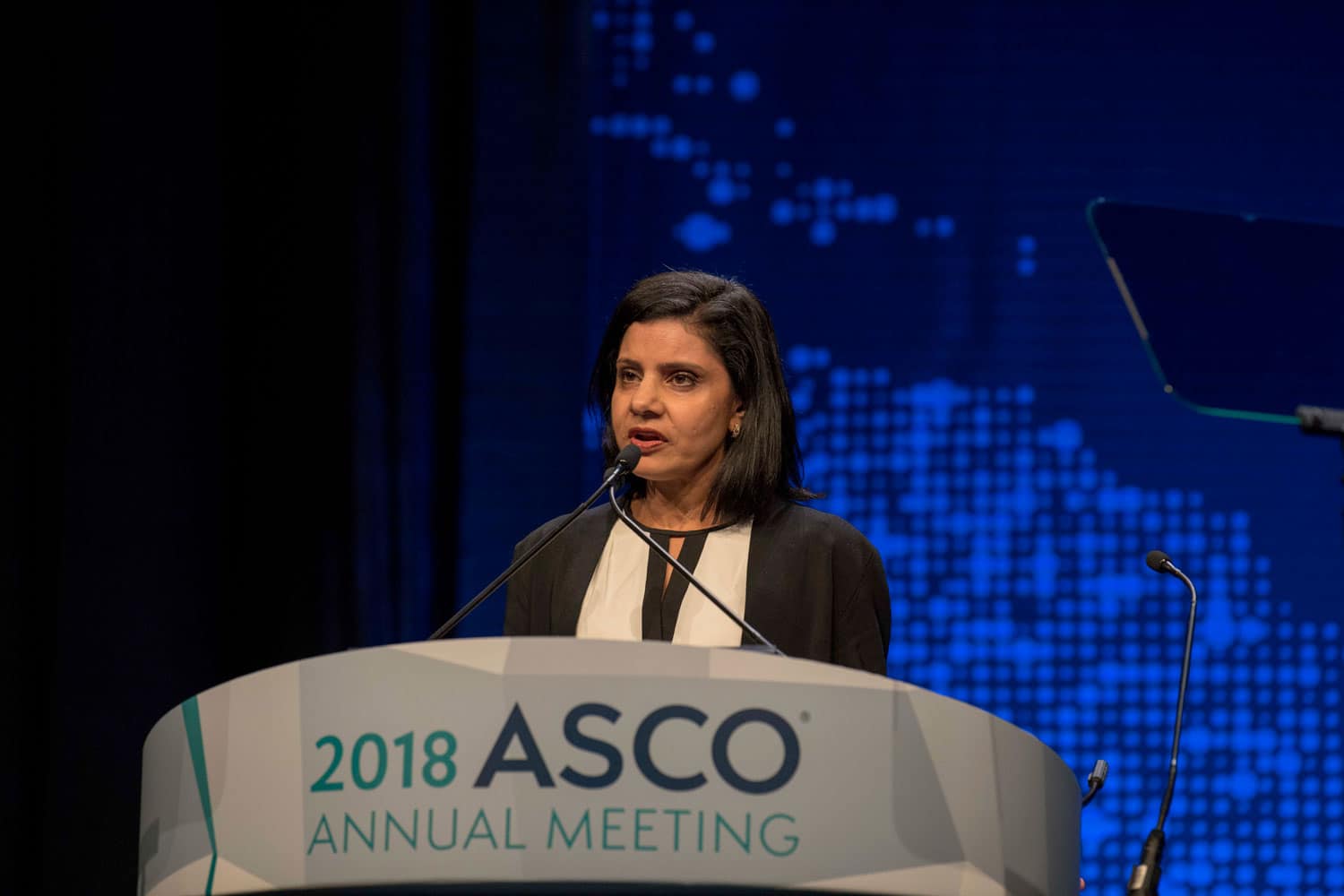
Gandhi, who currently leads a lung cancer immunotherapy trial sponsored by the CRI Clinical Accelerator, stressed that “lung cancer is no longer ‘one size fits all’” and that it’s imperative for doctors “to use biomarkers to select the best individual option for each individual patient.” Specifically, she focused her discussion on the two most well-studied biomarkers in lung cancer immunotherapy: PD-L1 expression and tumor mutation burden (TMB).
After going over the implications of Lopes’ Keynote-042 study, as well as of others such as CheckMate-227, Gandhi laid out “theoretical treatment scenarios” that suggested how patients with different biomarkers could be treated, based on what we now know about each of those characteristics.
In a patient whose tumors has high PD-L1 expression but a low TMB, for example, Gandhi suggested pembrolizumab as a reasonable option, whereas a patient whose tumor has low TMB and low PD-L1 expression would likely require a combination of chemotherapy and pembrolizumab to induce an effective anti-tumor immune response. She also proposed the combination of nivolumab (anti-PD-1) and ipilimumab (anti-CTLA-4) checkpoint immunotherapy for patients whose tumors had a high TMB but no PD-L1 expression.
In general, Gandhi claimed that single agent immunotherapy appears to be suitable for PD-L1-expressing tumors whereas those that lack PD-L1 expression should be treated with a combination approach.
During a lung cancer poster discussion session, Sarah Goldberg, MD, of the Yale Cancer Center, first spoke about a study that sought to characterize features that could predict which lung cancer patients treated with PD-1 immunotherapy were most likely to experience a long-term response. While high PD-L1-expressing tumors were enriched in the long-term responder group compared to non-long-term responders, there wasn’t much of a difference in PD-L1 expression between long-term and short-term responders.
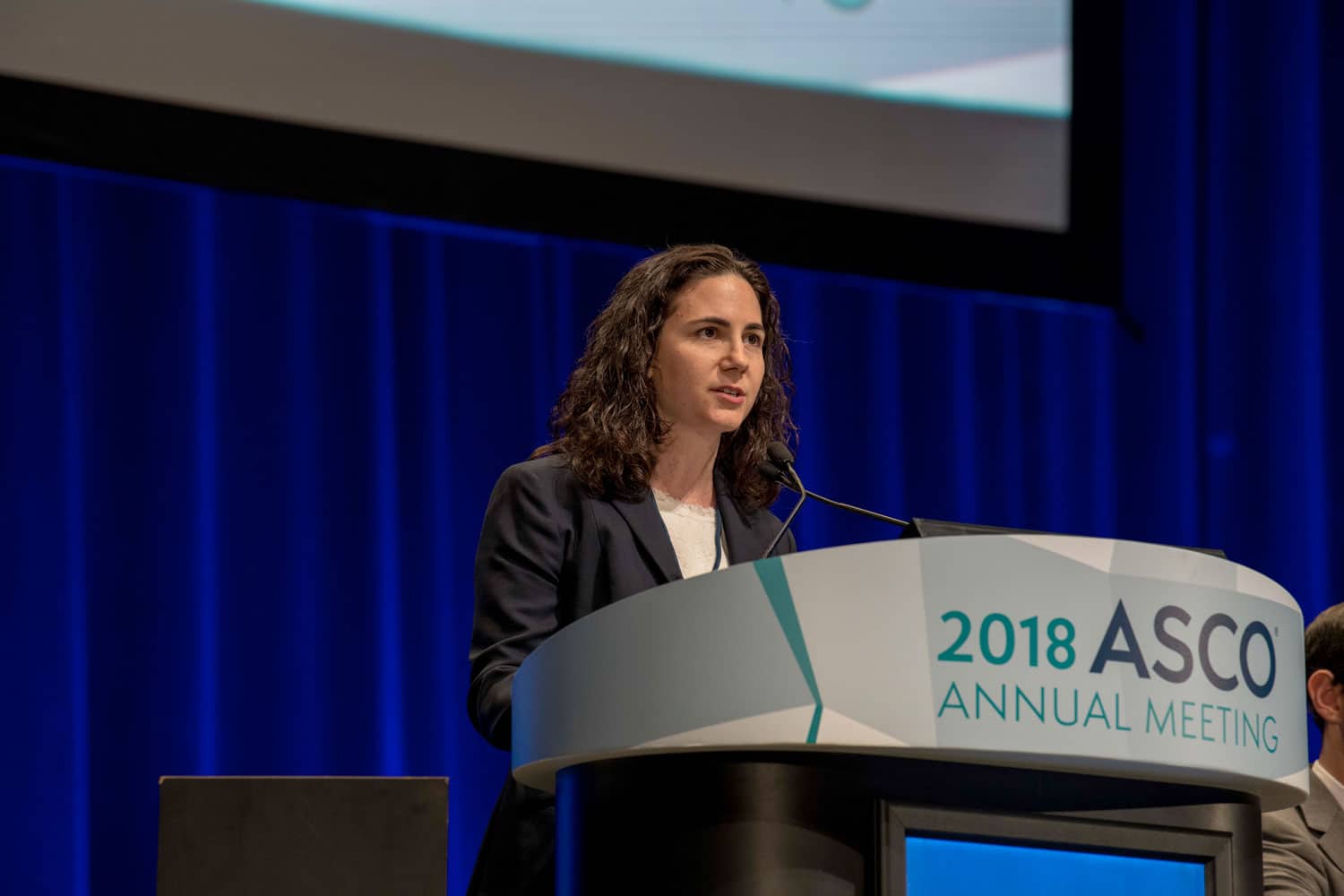
On the other hand, high TMB was mostly unique to long-term responders and was significantly associated with both initial and durable responses. The extent of a patient’s response also correlated with the duration of response: responses that were complete or near complete were much more likely to be long-lasting. Lastly, Goldberg noted that patients who experienced long-term responses were more likely to be smokers, and that none of their tumors possessed an EGFR mutation.
The second study Goldberg discussed involved treating advanced NSCLC patients with pembrolizumab after radiation. Compared to patients who received radiation alone, those who also received immunotherapy were almost twice as likely to respond, according to the response rate (39% versus 21%). Furthermore, the immunotherapy-treated patient group were associated with significantly improved progression-free survival (median of 7.1 months versus 2.8 months) as well as overall survival (media of 19.2 months versus 7.6 months).
During the same poster discussion session, Jhanelle Gray, MD, of Moffitt Cancer Center, provided insights into patient reported outcomes (PROs) in first-line combination immunotherapy trials in advanced lung cancer.
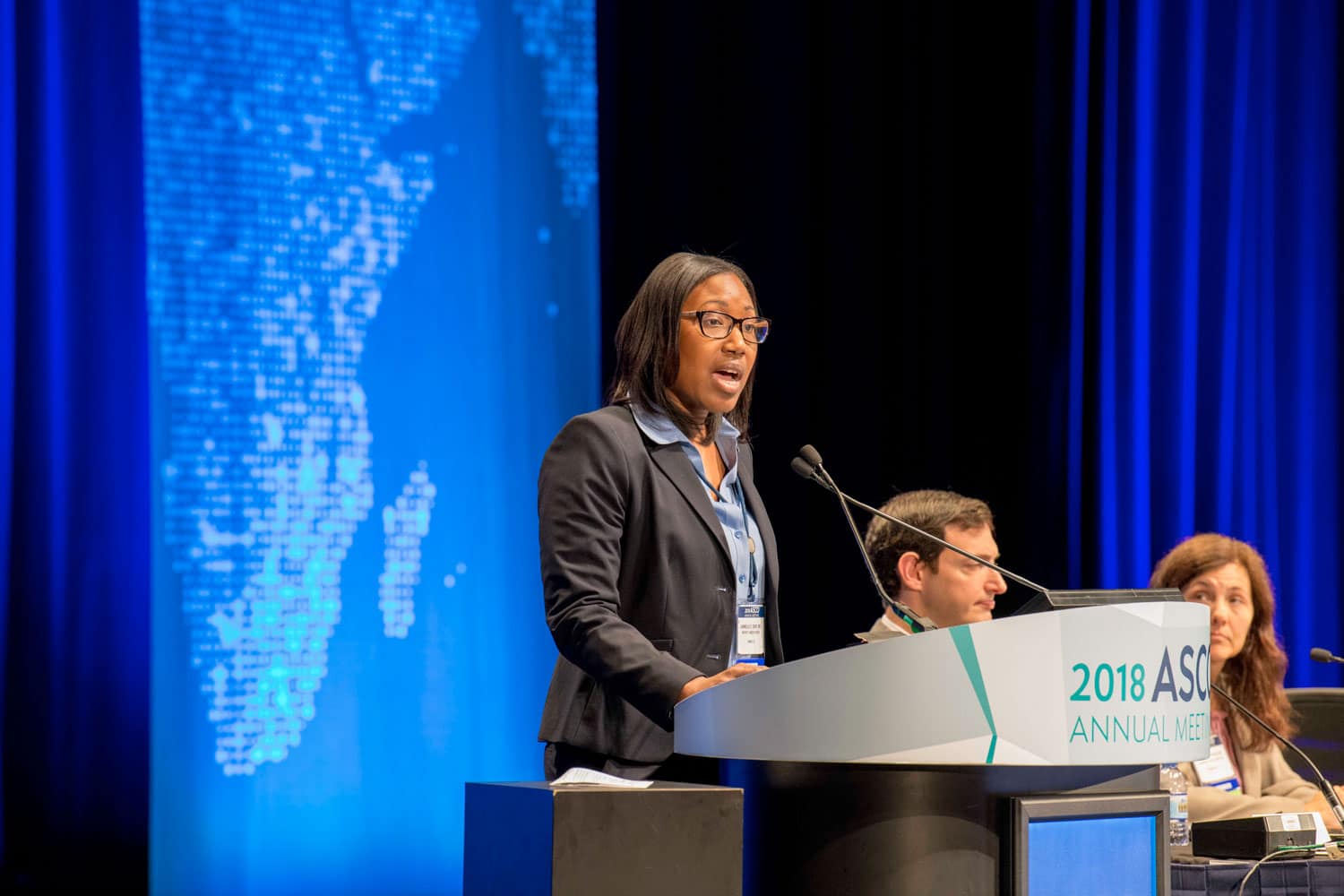
Gray, who is involved in a lung cancer immunotherapy trial sponsored by the CRI Clinical Accelerator, noted that PROs that “serve to bring the patient perspective to the forefront…have been shown to improve patient care, and help with the shared decision-making process.” They are also important given that, as she noted, “clinicians can at times underestimate toxicities reported by patients.”
She first focused on a study associated with CheckMate-227, which tested the checkpoint immunotherapy combination of nivolumab and ipilimumab as a first-line option in advanced NSCLC. In addition to providing superior progression-free survival benefits for NSCLC patients with high TMB—43% of the immunotherapy-treated patients had yet to have disease progression at one year, compared to 13% of chemotherapy-treated patients—this combination also led to early and sustained improvements in quality of life. These PROs also carried significant weight, given that completion rates were roughly 90% at the beginning and typically remained above 80% during subsequent assessments.
Subsequently, Gray discussed a study associated with Keynote-189, which involved treatment of metastatic NSCLC with a chemotherapy combination with or without pembrolizumab. Overall, the addition of immunotherapy led to improved rates of response (47.9% versus 18.9%), overall survival (69.2% at the one-year mark versus 49.4%), and progression-free survival (34.1% versus 17.3%) in patients compared to chemotherapy alone. The immunotherapy cohort was also characterized by equivalent or improved quality of life compared to chemotherapy.
Rounding out our lung coverage from Day 3 is D. Ross Camidge, MD, PhD, of the University of Colorado, who discussed two novel immunotherapies being evaluated in trials for patients with advanced NSCLC. The results of both of these approaches in different cancer types were discussed in our blog from yesterday.
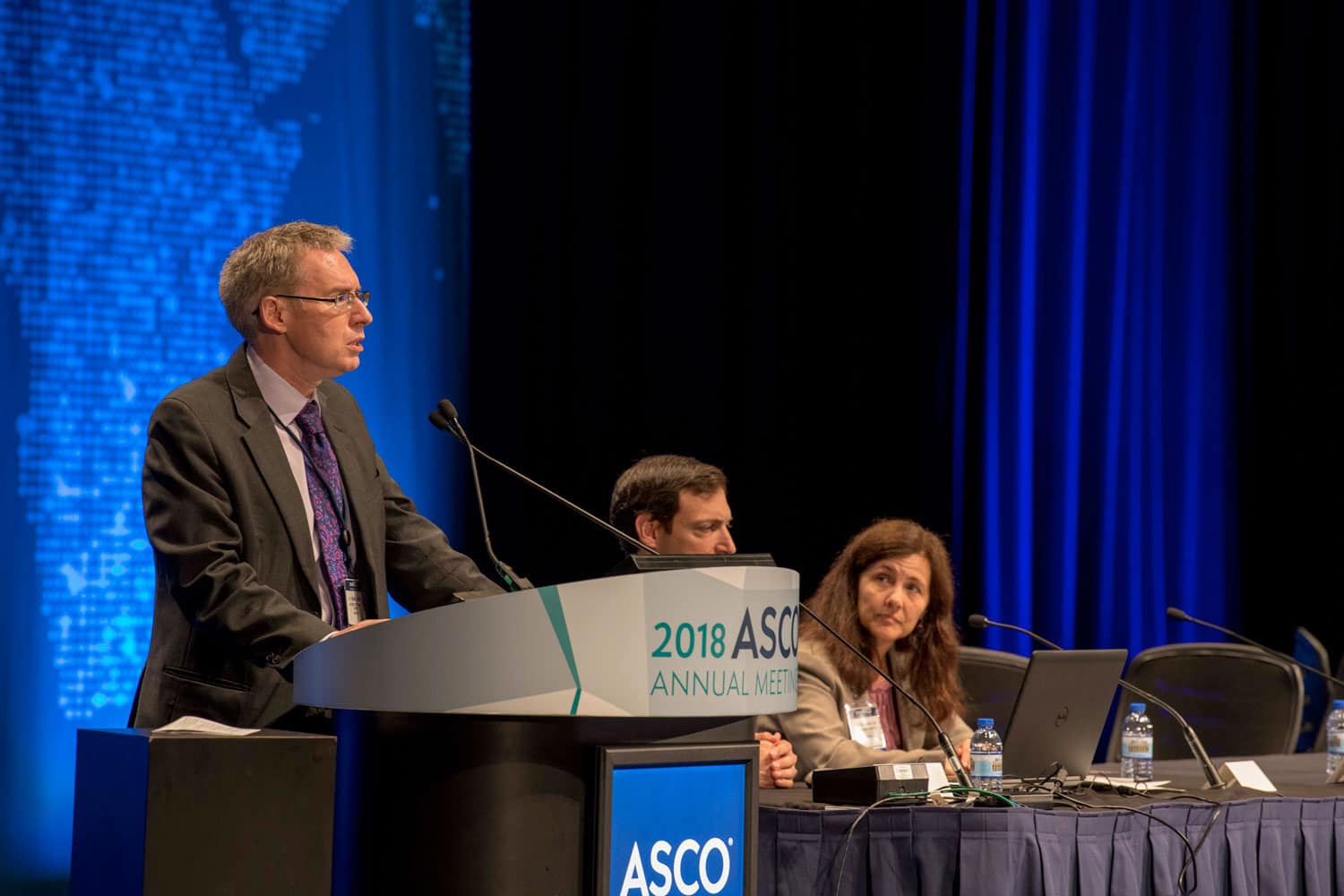
One trial Camidge discussed involved M7824, a bifunctional fusion protein which targets both PD-L1 and TGF-b, which was associated with a 21.3% response rate in patients regardless of PD-L1 expression, as well as a 27.6% response rate in patients with PD-L1+ tumors and a remarkable 62% response rate in patients with PD-L1-high tumors.
Next, he turned his attention to the combination of PD-1 immunotherapy and pegilodecakin, also known as AM0010, which is a form of the immune-modulating interleukin-10 cytokine. This combination provided promising efficacy—and a 41% response rate—across the PD-L1 expression spectrum. In patients with PD-L1-high tumors, the response rate and disease control rate were 80% and 100%, respectively, whereas 33% of patients with PD-L1-negative tumors responded and another 59% experienced disease stabilization. In addition to significant responses in patients whose tumors were relatively highly mutated, this combination also benefited patients whose tumors had low TMB (< 243 mutations), generating a 63% response rate and 100% disease control rate. However, it should be noted that these subgroups were composed of very small numbers of patients, and the findings will need to be validated in larger studies.
In ovarian cancer, Lukas Rob, MD, PhD, of the University Kralovske Vinohrady in Prague, Czech Republic, highlighted results from a trial involving a dendritic cell vaccine that was used to treat patients along with chemotherapy after prior de-bulking surgery. To create the vaccine, Rob’s team used hydrostatic pressure to destroy ovarian cancer cells in an immunogenic way. Then, the patients’ isolated dendritic cells were exposed to the dead tumor cells, followed by induction of the maturation process in the dendritic cells.
While the vaccine yielded little benefit when it was administered at the same time as chemotherapy, it proved quite effective when it was administered after the immune system was able to fully recover from the chemotherapy’s cytotoxic effects. In the 92 patients who received at least one dose of the dendritic cell vaccine, there was a six-month benefit in terms of median progression-free survival (24.3 months versus 18.6 months), which was associated with a hazard ratio of 0.43, which dropped to 0.32 in the group of 87 patients who received at least eight doses of the vaccine. While the median overall survival was not yet reached, there was a strong trend toward improved overall survival in the vaccine-treated group, as evidenced by a hazard ratio of 0.13.
Panagiotis Konstantinopoulos, MD, PhD, of the Dana-Farber Cancer Institute, also gave a talk on ovarian cancer immunotherapy. In the Keynote-162/TOPACIO trial, his team treated patients with platinum-resistant ovarian cancer with the combination of pembrolizumab and niraparib, a PARP inhibitor. Among the 60 patients who were evaluable, 25% had objective responses, including 5% who had complete responses, and the overall disease control rate was 67%. These responses were even more frequent in patients with BRCA mutations, who has a 45% response rate and a 73% disease control rate.
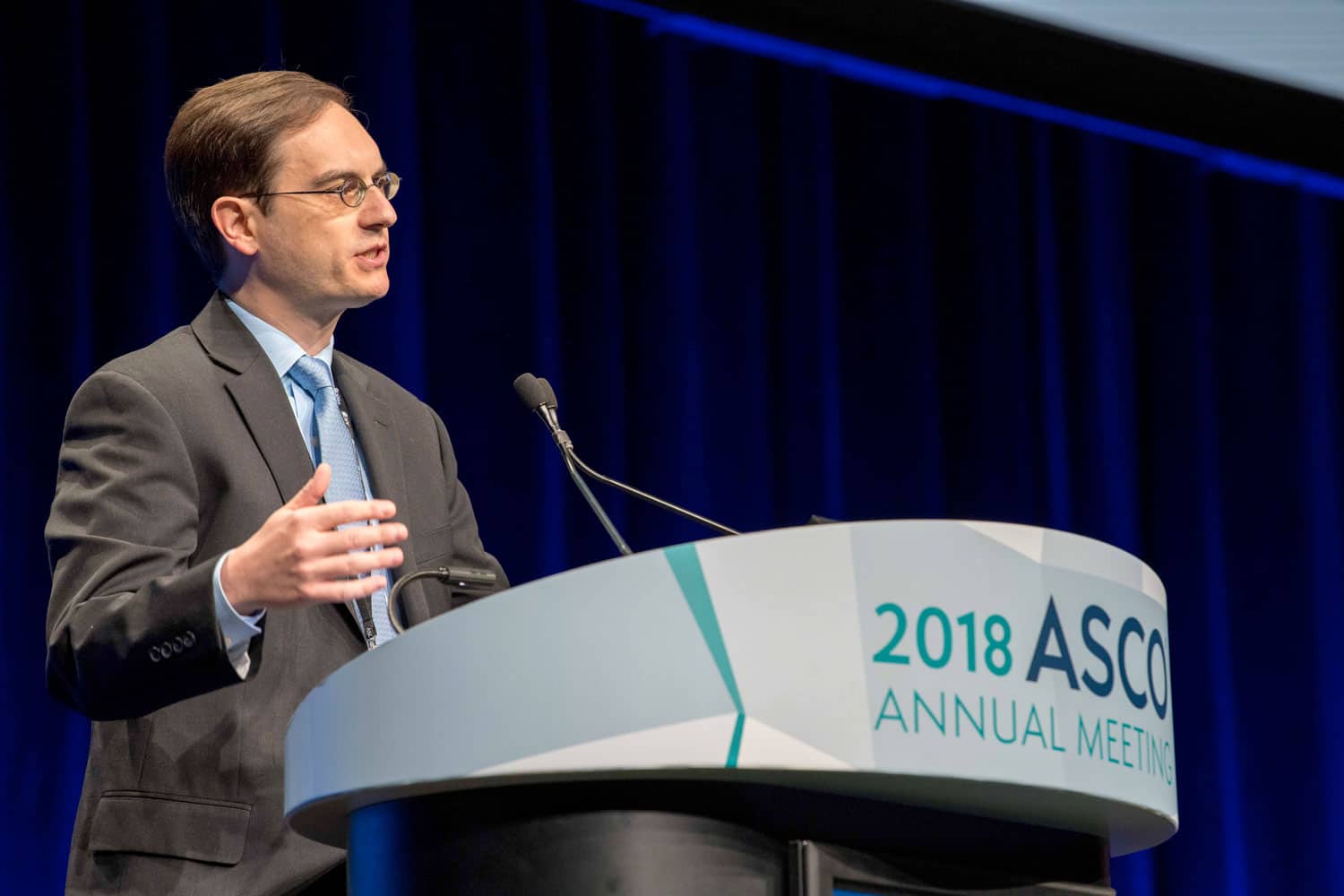
In breast cancer, Sibylle Loibl, MD, of the German Breast Group, showcased her team’s work on a trial that treated triple-negative breast cancer patients with the combination of durvalumab, an anti-PD-L1 checkpoint immunotherapy, and chemotherapy. The patients who received the combination had a 53.4% pathological complete response (pCR) rate, compared to a 44.2% pCR rate in those who only received chemotherapy. While these results weren’t significant for the entire treatment population, the combination’s benefits in terms of pCR rates were significant compared to chemotherapy in the following subsets of patients: those who received durvalumab prior to chemotherapy (61% versus 41%), those with stage II disease or worse (55.8% versus 38.6%), and patients under the age of 40 (69.2% versus 42.9%).
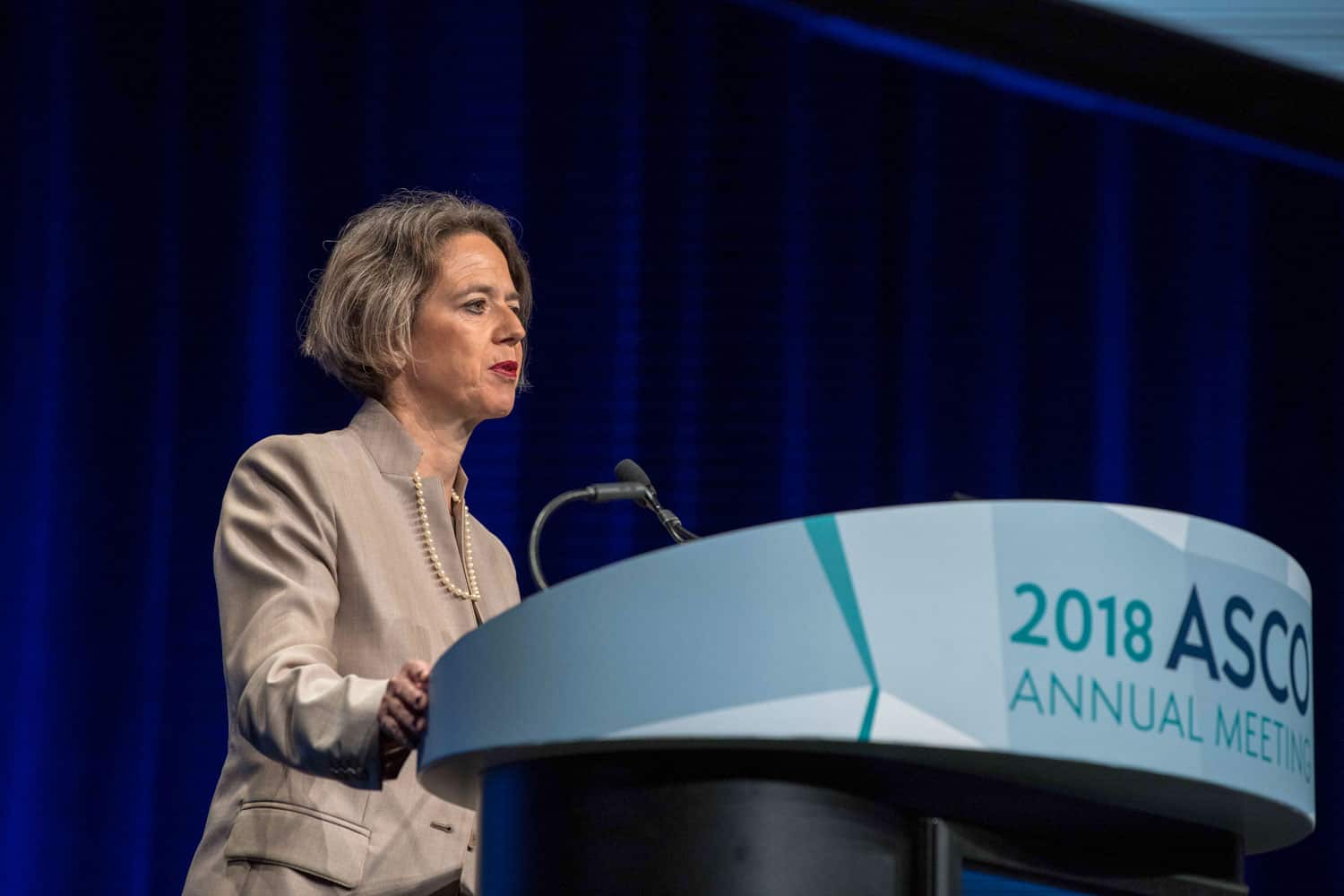
Finally, Georgina V. Long, MD, PhD, a CRI Clinical Team Leader at the Melanoma Institute Australia, unveiled the anticipated results of a phase III trial that compared pembrolizumab alone to the combination of pembrolizumab and epacadostat, an IDO1 inhibitor, in patients with unresectable or metastatic melanoma. While patients in both groups fared fairly well—roughly one-third of all patients responded—unfortunately the addition of epacadostat didn’t provide any additional clinical benefit.
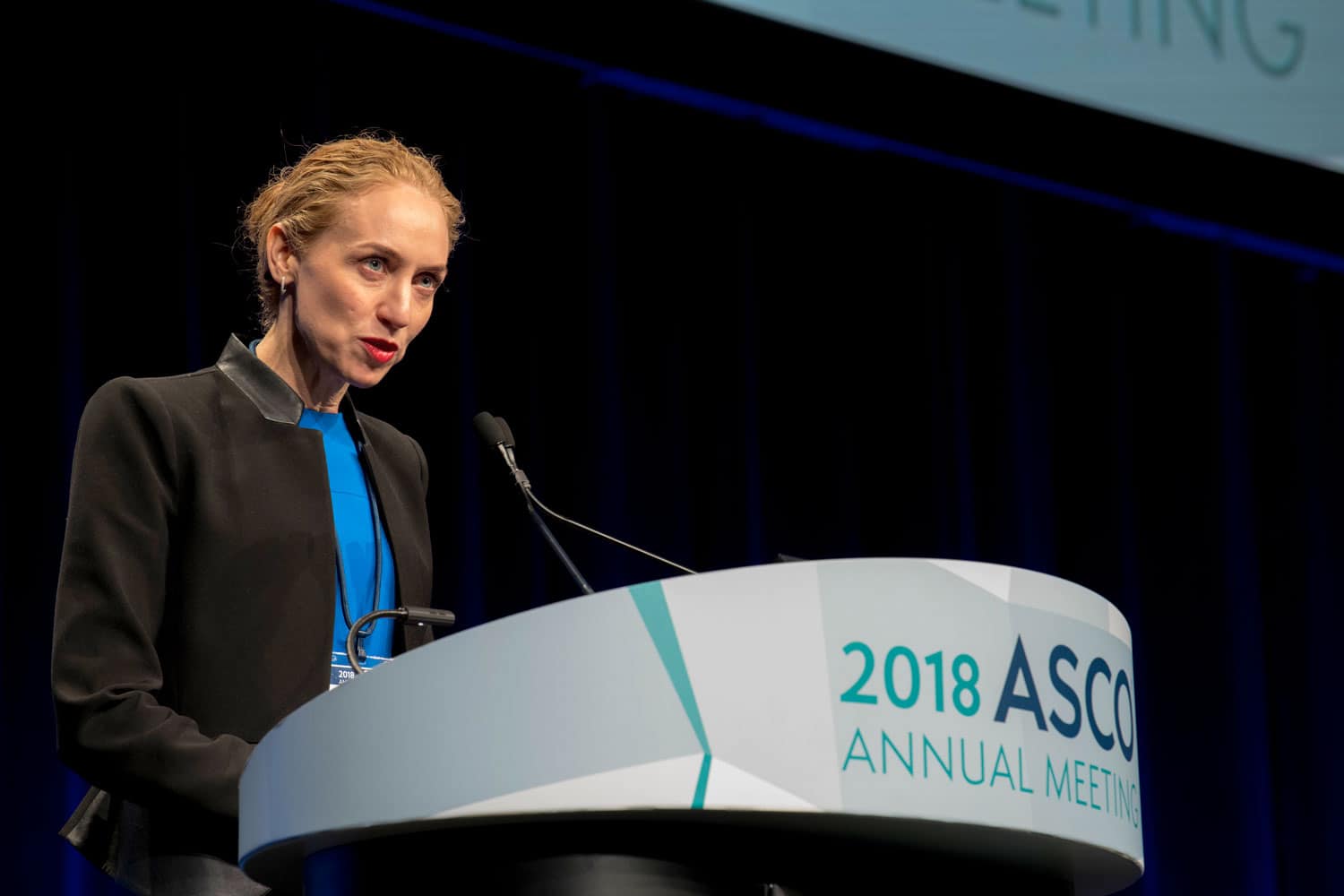
During the subsequent discussion of this trial, Charles G. Drake, MD, PhD, of New York-Presbysterian and the Columbia University Medical Center, wondered what happened, whether the drug wasn’t able to effectively inhibit IDO1 in humans the way it did in the preclinical models, in which it previously showed promise, or whether it was successfully inhibited and just didn’t impact anti-tumor immunity. Either way, this was an unfortunate setback for an approach that many thought had great potential—numerous trials involving the drug were halted in April this year when the study results were first published, though many scientists believe the approach merits further—and more thorough—study. This led Drake to ask, “In the age of combinations, do we need randomized phase II trials prior to phase III?” Presumably, he, and many others feel strongly that the answer is “yes.”
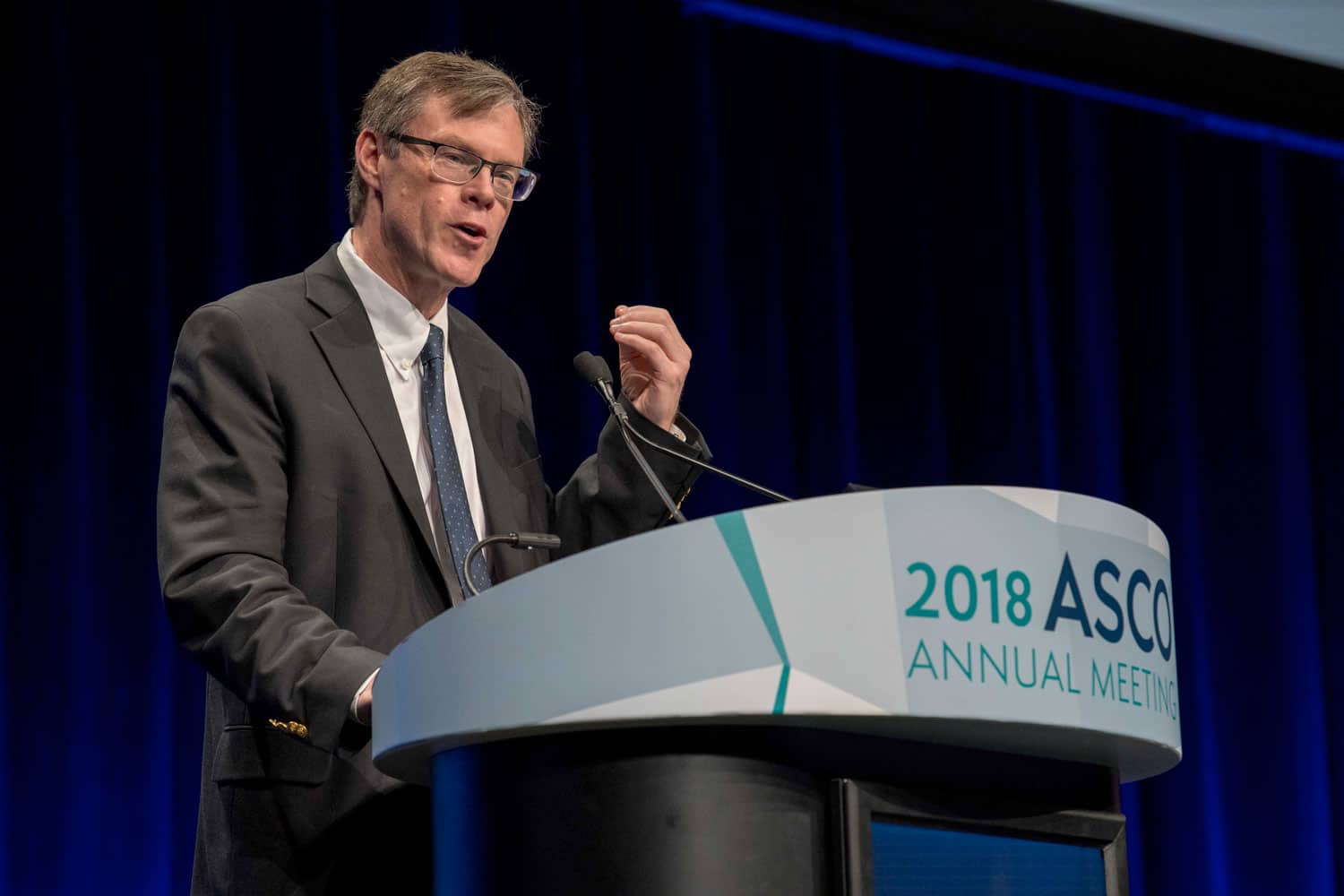
Be sure to check out our blog tomorrow for highlights from what is sure to be an exciting and immunotherapy-packed Day 4 at ASCO18!

